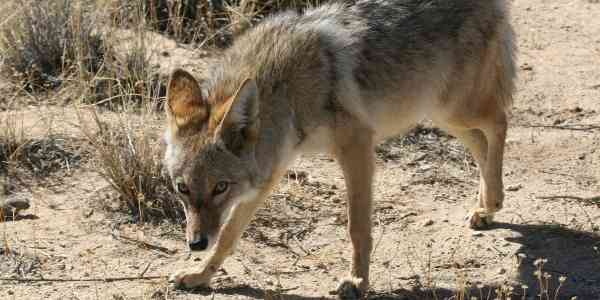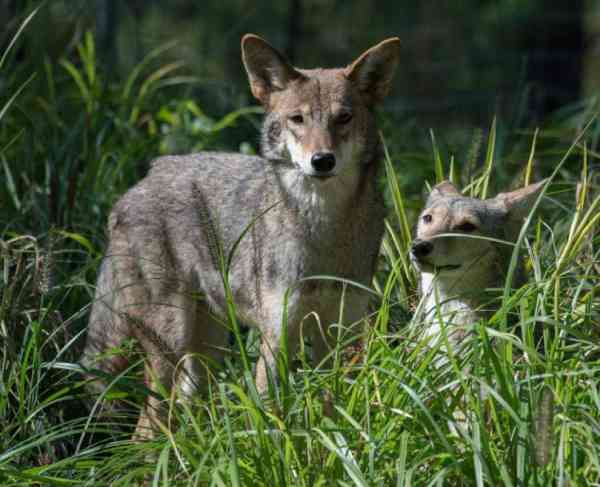In Ohio, the coyote is a species that has become increasingly recognizable in recent years. They have covered large parts of the state, ranging from residential urban areas to rural farmland. Coyotes are highly adaptable and can survive in many different climate conditions, making them an ideal species for Ohio’s diverse landscape. Typically solitary animals, these canine scavengers can be determined predators and wary of human contact but also incredibly crafty when it comes to accessing food and shelter.

Table of Contents
Habitat
The coyote is an adaptable creature that can thrive in a wide range of climates and temperatures and as such is equipped to handle the changing weather conditions found in Ohio. Since they are known to travel frequently in search of food, coyotes may move between woodlands, agricultural fields and even urban environments. They will typically make their dens on the edges of wooded forests or on banks or bluffs along rivers and lakes. Coyotes also prefer areas with thick underbrush or shrubs when seeking out their dens and den sites, as these offer them good protection from inclement weather marked by cold winters and hot summers in Ohio.
Diet
Coyotes generally consume a very varied diet. They feed on small mammals such as mice and voles, but also enjoy eating fruits like berries and apples, insects, reptiles and ground-dwelling birds. Plant matter such as grass or even corn may also be taken advantage of when the opportunity arises. Deer carrion can be an important food source for these opportunistic animals. The diet of coyotes largely depends on the season and availability of different food sources. As they are nocturnal animals, coyotes are known to scavenge pastures at night as well as hunt during both day and night depending on their needs in order to survive.
Colour
The colour of coyotes in Ohio varies, depending on the season. During summer months, these predators often boast thick fur that is typically a mix of red and grey hues, blended together to make their coats appear almost brown. In winter months, however, the colour of their fur transitions into an overall grey tone.

Size, Lifespan and Weight
The average size of these creatures is between four and six feet long, depending on their age and gender. These animals live anywhere from ten to thirteen years but some can reach nearly fourteen years in age. The average weight of an adult coyote is only 30 pounds but this varies again depending on the sex of the animal and which specific breed it belongs to.
Predators
Ohio boasts a diverse range of wildlife, and the coyote is just one of the iconic species found throughout the state. These predators, who primarily hunt small mammals must also watch out for their own predators. Bears, wolves, mountain lions and even other coyotes all have been known to prey on Ohio’s coyotes. One of the most common predators of coyotes are fellow humans; whether through hunting or trapping, humans remain the leading factor in decreasing Ohio’s coyote population.

Reproduction
They reproduce once a year, between January and March. Males typically remain with their family group for the first year, and often even longer, while females will rarely leave once they hit maturity. The average litter size of coyotes is four to six pups, which are born blind, deaf and without fur for about three weeks. During this time period, coyotes rely on vocalizations such as yelping or barking to communicate and ward off predators. By six months old, the pups will begin learning hunting skills from their parents.
Hunting Coyotes in Ohio
Hunting coyotes in Ohio offers hunters a unique challenge. With predators like bobcats, foxes, and raccoons sharing the landscape, it can be difficult to find and track coyotes. When hunting seasons are open for other species, competition can increase and make it more difficult to hunt the sagebrush-country specialist.

What nuisance do Coyotes in Ohio make?
Coyotes in Ohio have a habit of making noise at night, which can be quite an annoyance. Contrary to popular belief, they aren’t usually interested in attacking humans or animals – they’re simply looking for food. Their presence also often has a negative effect on wildlife habitat, as well as disruption of ecosystems by killing off vulnerable species.
Coyotes in Ohio sounds
The sound of a pack of coyotes howling in unison is a distinct and eerie noise, especially in the night sky. Ohio is home to several packs of coyotes that often roam during the night and produce their signature call. Coyotes are social animals, and they typically howl to mark their territory and reintegrate after some time apart. They are very loud animals, able to make others aware of their presence over great distances.
References:
https://ohiodnr.gov/discover-and-learn/animals/mammals/coyote
https://www.coyotesmarts.org/what-to-do/
https://www.humanesociety.org/resources/what-do-about-coyotes
https://www.westchesteroh.org/Home/Components/News/News/2797/

Rahul M Suresh
Visiting the Zoo can be an exciting and educational experience for all involved. As a guide, I have the privilege of helping students and visitors alike to appreciate these animals in their natural habitat as well as introducing them to the various aspects of zoo life. I provide detailed information about the individual animals and their habitats, giving visitors an opportunity to understand each one more fully and appreciate them in a more intimate way.









